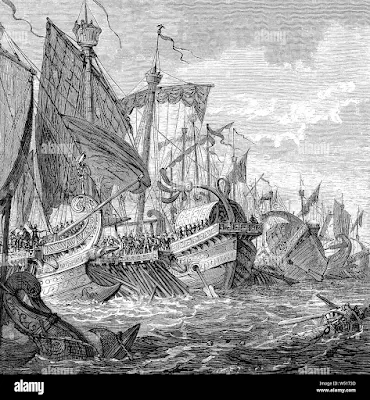 |
| The punic war |
Uncovering the Epic Saga: A Complete Guide to the Punic Wars (264-146 BCE)
Introduction
The Punic Wars were a series of conflicts that would shape the course of history for centuries to come. These wars, which lasted from 264 to 146 BCE, were titanic confrontations between two mighty Mediterranean civilizations: Rome and Carthage. In this essay, we will travel across time to investigate the complexities, important events, and long-term consequences of the Punic Wars.
Setting the Scene: Conflict Origins
To really comprehend the scope of the Punic Wars, one must first investigate the conflict's beginnings. The competition between Rome and Carthage was based on profound economic, political, and geographical roots. We'll look at the growth of these two powerful nations, as well as the tensions that finally led to all-out war.
The Battle of Sicily (264-241 BCE) was fought during Punic War I.
The first Punic War paved the way for the legendary battles that followed. The fight, which centred on the key island of Sicily, demonstrated naval power, ground conflicts, and the sheer determination of both Rome and Carthage. We'll go over the important encounters, tactical advancements, and the ultimate peace treaty that marked the conclusion of this first conflict.
Uneasy Peace and Rising Tensions During the Interwar Period
Following the First Punic War, there was a period of uneasy quiet. However, festering resentments and power battles pave the way for the unavoidable second confrontation. We'll look at the diplomatic manoeuvring, internal struggles, and events that rekindled the embers of conflict between the two old superpowers.
Hannibal's Daring Campaign during Punic War II (218-201 BCE)
The Second Punic War, without a doubt the most memorable chapter of the Punic Wars, unfolded with the bold military brilliance of Hannibal Barca. From his daring Alps crossing to the Battle of Cannae, we'll uncover Hannibal's strategic brilliance and tactical masterstrokes that marked his war against Rome. The war's influence on both civilizations, as well as its lasting legacy, will be analysed.
The Decisive Battle: Punic War III (149-146 BCE)
Carthage was completely destroyed in the final episode of the Punic Wars. The Third Punic War, frequently overshadowed by Hannibal's accomplishments, marked the terrible end of a once-mighty empire. We'll look at the causes, significant battles, and Rome's contentious choice to annihilate Carthage, which left an everlasting effect on history.
The Punic Wars' Legacy and Impact on History
The Punic Wars had long-lasting consequences, altering the geopolitical landscape of the Mediterranean and beyond. We'll look at how these battles changed the course of history and laid the way for Rome's ascent as a worldwide power, from the extension of the Roman Republic to the dissemination of Hellenistic culture.
Lessons from the Past: The Punic Wars and Their Importance Today
We'll draw analogies between historical battles and modern geopolitical processes in the last segment. The Punic Wars provide important insights on the costs of unrestrained ambition, the value of diplomacy, and the long-term effects of warfare on civilizations.
Conclusion
The Punic Wars are a monument to ancient civilizations' durability, strategic genius, and fundamental weaknesses. We develop a comprehensive grasp of the forces that moulded the ancient world by studying the important events, people, and legacies of these fights. As we reflect on the rise and fall of Rome and Carthage, we are reminded that history is a complex tapestry of human endeavours, aspirations, and the continuous struggle for power and glory, not just a collection of dates and conflicts.
1.What were the primary reasons for the Punic Wars?
Deep-seated economic, political, and territorial rivalry between Rome and Carthage drove the Punic Wars. The battle for Mediterranean control, notably over vital regions such as Sicily, and rivalry for trade routes were among the primary reasons of these epic confrontations
2.Who were the main characters in the Punic Wars, and what role did they play?
Hannibal Barca, a Carthaginian military prodigy, is undoubtedly the Punic Wars' most renowned character. His brave campaign during the Second Punic War, which included the famed Alps crossing, remains legendary. Furthermore, Roman generals such as Scipio Africanus influenced the result of these fights.
3.What were the Punic Wars' biggest battles, and which had the most impact?
Several major conflicts occurred during the Punic Wars. The Battle of Mylae and the Battle of Cape Ecnomus were key naval battles during the First Punic War. The Battles of Cannae and Zama were pivotal confrontations in the Second Punic War, with long-lasting consequences.
4.After the Third Punic War, why did Rome decide to destroy Carthage?
The destruction of Carthage during the Third Punic War was the outcome of Rome's intense hatred for its competitor. Despite Carthage's cooperation with Rome's requests, the Romans chose absolute devastation over a rebirth of Carthaginian dominance. This decision has long-term ramifications for the Mediterranean's geopolitical environment.
5.How did the Punic Wars influence history beyond the ancient world?
The Punic Wars had a significant and long-lasting influence on history. They highlighted the rise of Rome as a dominating force in the Mediterranean, eventually contributing to the foundation of the Roman Empire. The battles also affected the expansion of Hellenistic culture, the redrawing of regional boundaries, and set the scene for the ancient world's geopolitical dynamics. The lessons from these events are still being discussed in talks about diplomacy, warfare, and the repercussions of unrestrained ambition.
Comments
Post a Comment